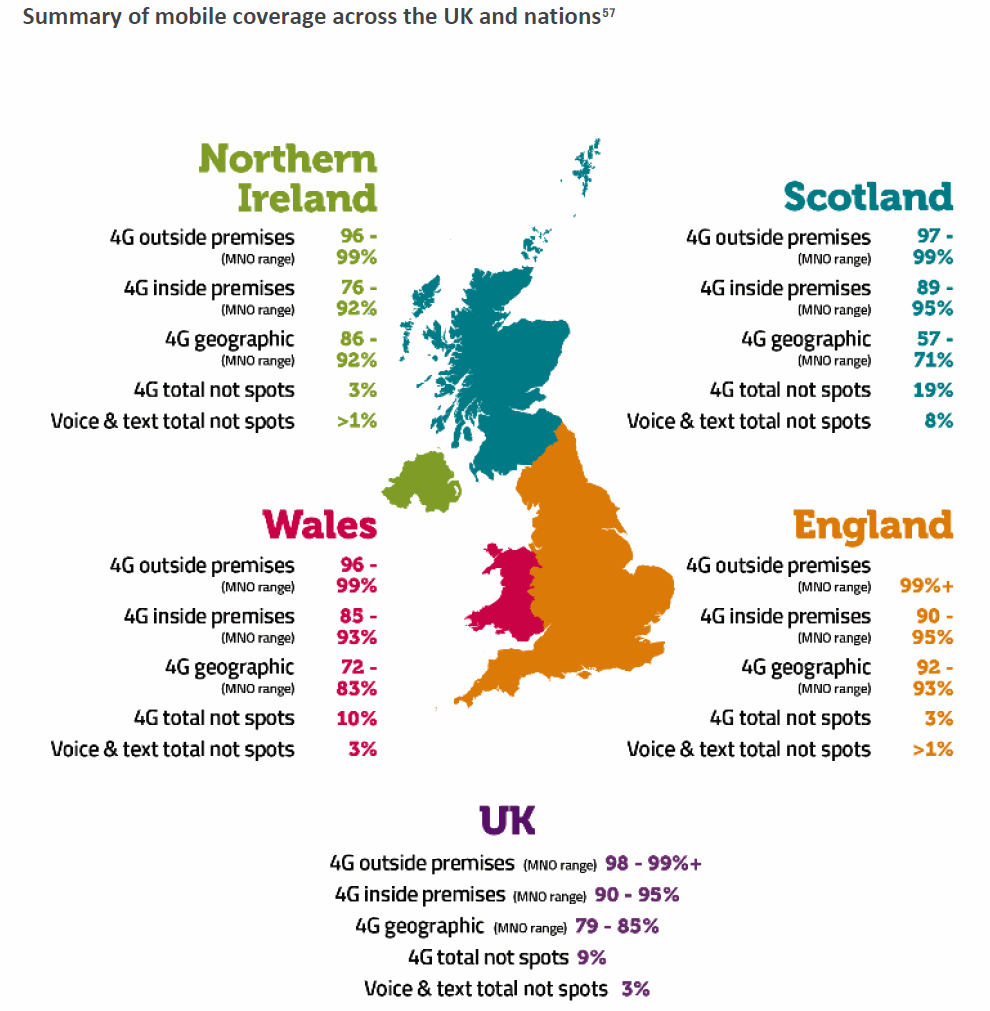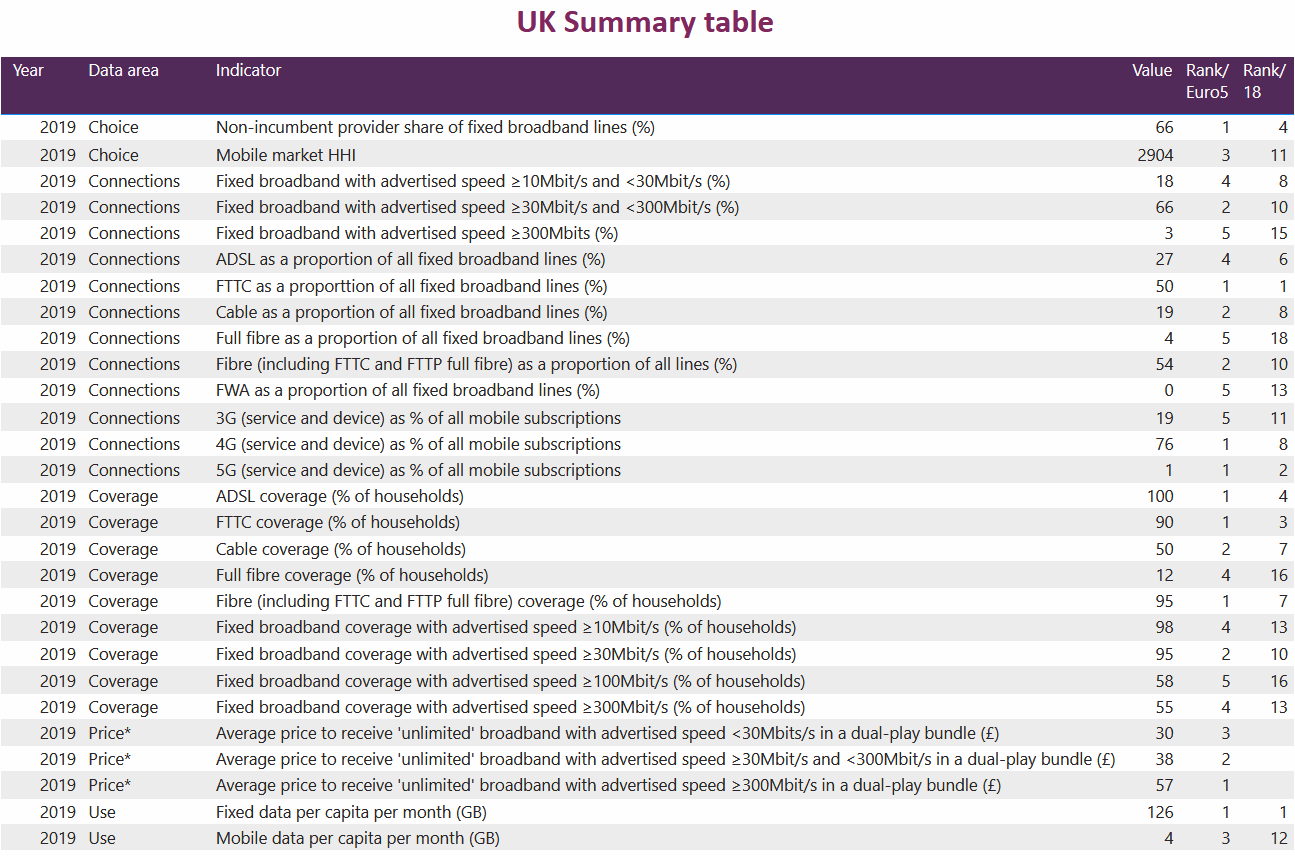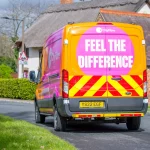Connected Nations 2020 – UK Full Fibre Covers 5 Million Premises

Ofcom has published their annual Connection Nations infrastructure report, which reveals that “full fibre” (FTTP) broadband ISP networks now cover 18% of UK premises (up from 10% last year) and 27% are within reach of a “gigabit” (1Gbps+) service (7.9 million). Meanwhile geographic 4G cover is given as a range from 79% to 85%.
The report provides a general summary of broadband and mobile network availability and data usage from across England, Scotland, Wales and Northern Ireland, although it’s largely based off data that was gathered a few short months ago (September 2020).
Before we begin it’s important to note how Ofcom defines the different performance classes of fixed broadband. In that sense, “Decent Broadband” usually means a 10Mbps+ download speed (i.e. Universal Service Obligation), while “Superfast” is 30Mbps+, “Gigabit” equates to 1000Mbps+ or 1Gbps+ and “Full Fibre” essentially means a pure Fibre-to-the-Premises network (these are also gigabit speed).
Advertisement
Meanwhile, the regulator appears to have dropped their “ultrafast” (300Mbps+) category this year (less relevant given the focus on gigabit speeds) and they now give the geographic (landmass) coverage on mobile networks as a range rather than a single figure. The latter change makes more sense given the big differences in availability between EE, O2, Vodafone and Three UK.
Otherwise, we’ll split our summary of the key results from this report into categories for fixed line broadband and mobile.
Fixed Line Broadband Coverage
The main focus during 2020 has been the on-going deployment of FTTP broadband networks by various providers (Summary of UK Full Fibre Build Progress) and Virgin Media’s rapid upgrade to DOCSIS 3.1 technology (here), both of which have predominantly focused upon urban areas. All of this reflects the fact that, at present, it’s commercial investment driving gigabit-capable networks.
The Government’s new £5bn ambition, which aims to make gigabit speeds available to at least 85% of UK premises by end of 2025 (here), is likely to change this picture because that has a focus on supporting those in the hardest to reach final 20% of premises. However, deployments under that programme are unlikely to even begin for another year or so (here), and will most likely continue well past 2025.
Advertisement
Overall, the picture today is that UK “full fibre” network coverage has risen from 3% in 2017, to 6% in 2018 (1.8 million premises), then 10% in 2019 (3 million premises) and now 18% (5.1 million premises). Meanwhile “gigabit” coverage, which is being driven by both “full fibre” and Virgin’s (DOCSIS) network (there’s a lot of overbuild between these), has grown to 27% – it’s going up rapidly due mostly to both the DOCSIS 3.1 upgrade of existing hybrid fibre coax lines.
Meanwhile “superfast” coverage jumped by 1% to 96% (but only 81% in rural areas) and the number of premises that cannot get a “decent broadband” (10Mbps+) service is 0.6% or 190,000. But this is only if you factor-in 4G and fixed wireless coverage to the 10Mbps figure (if you only looked at fixed line solutions it would be closer to 2% or 590,000 premises), although many of those that remain are too expensive for even the USO to fix (here).
On this point we note how Ofcom estimates that 43,000 premises cannot access either a 10Mbps+ fixed broadband service, or good 4G coverage, indoors.

Advertisement
In terms of take-up, some 60% of connections are now “superfast” (up from 57% last year, 45% in 2018, 38% in 2017 and 31% in 2016). Meanwhile just 25% have taken a “full fibre” network, which is actually down from 30% last year and that’s due to the rapid pace of build (it can take 1-2 years to grow a good level of initial take-up AFTER a network has been built, so a rapid build will suppress this). But clearly a lot of people could now upgrade to a faster connection if they wanted.
Elsewhere, the average monthly data volume per household on fixed broadband connections has increased over the past year to 349 GigaBytes (up from 315GB in 2019 and 241GB in 2018).
Lindsey Fussell, Ofcom’s Network and Communications Group Director, said:
“For millions of families this year, life during lockdown would have been even more difficult without reliable broadband to work, learn, play and see loved ones.
So it’s encouraging that future-proof, gigabit broadband is now available to a quarter of homes, and we expect that to rise even faster in the coming months.”
Mobile Coverage
The report includes coverage data for mobile networks, such as via the usual 2G (voice & text) and 4G based platforms that most people should be familiar with. The UK has four primary network operators (MNO) – O2, Three UK, EE (BT) and Vodafone – plus an assortment of virtual operators (MVNO) that piggyback off those.
Overall Ofcom found that between 79% to 85% of the UK’s landmass can access a 4G network if you look across all operators (last year they just gave a single figure of 66%). The new £1bn Shared Rural Network agreement aims to push geographic 4G coverage to 95% by the end of 2025 (here), but historically similar efforts have struggled to deliver on their promises and the SRN won’t have had much of an impact yet (too new).
Sadly, the regulator hasn’t published a proper coverage figure for the new generation of 5G mobile networks yet, which is very disappointing. But they do state that the number of mobile base stations providing 5G services has risen ten-fold, to around 3,000 across the UK. Some 87% of these are in England, 7% in Scotland and 3% in both Wales and Northern Ireland.

Digging deeper we were able to find some coverage figures for individual mobile operators, although we think that Ofcom hasn’t yet updated this data correctly and are querying it (UPDATE – We’ve added Ofcom’s corrected figures below).
2020 Geographic UK 4G Coverage by Operator
85% – EE (up from 84%)
82% – Vodafone (up from 80%)
79% – Three UK (unchanged from 79%)
80% – O2 (up from 76%)
Most network operators are currently reaching maturity in their 4G deployments, although EE did previously set itself a goal for landmass coverage of 95% by the end of December 2020 (currently c.91%), but this is likely to have changed as a result of the SRN deal and Ofcom uses different methodology for calculating such coverage. Check out the full Connected Nations 2020 report.
International Comparison
Alongside this report Ofcom has also published their latest international comparison, which pits the United Kingdom’s broadband and mobile connectivity against both the EU’s four major economies (France, Germany, Spain and Italy) and various other large countries. The data on this front is from 2019 and thus the figures are lower than those reported above (e.g. the UK is only on 12% for full fibre coverage below).

Overall, we still do well for “superfast” coverage, but are near the bottom for full fibre, although that rollout is currently going through a rapid ramping-up phase. We think the EU’s own annual Broadband Progress report is better presented and more readable (here), or the FTTH Council Europe’s country ranking (here).
Mark is a professional technology writer, IT consultant and computer engineer from Dorset (England), he also founded ISPreview in 1999 and enjoys analysing the latest telecoms and broadband developments. Find me on X (Twitter), Mastodon, Facebook, BlueSky, Threads.net and Linkedin.
« Broadband ISP TalkTalk UK SOLD to Toscafund in £1.1bn Deal UPDATE
Three UK Sees Average Mobile Data Use Per Customer Hit 15GB »






















































FTTP, which is in reality under covering FTTLA+GFast for most of it, is far from being “full fibre”. Terminal part is still using copper, even if it’s just for few meters. Same goes for DOCSIS cable.
There are only few real full fibre FTTH initiatives in the UK (hyperoptic and co), whereas France, Belgium, Spain, Italy, etc have all rolled out nation wide FTTH networks. Some of which offer now 5Gbps or 10Gbps plans…
G.fast is an entirely separate product and not mixed in with the FTTP figures above. Plus there are lots of true FTTP providers in the UK now:
https://www.ispreview.co.uk/index.php/2020/04/summary-of-full-fibre-build-progress-across-uk-broadband-isps.html
“FTTP, which is in reality under covering FTTLA+GFast for most of it, is far from being “full fibre”. Terminal part is still using copper, even if it’s just for few meters.”
You what?
You’re making that up.
I can assure you that OpenReach FTTP is full fibre right to the ONT.
G.Fast isn’t counted in the full fibre figures at all.
G.Fast is FTTC, with the same length of copper as VDSL2 (minus the tie cables).
Virgin FTTP (RFOG) has LESS THAN 2m of coaxial from the outside media converter to where my Virgin Hub used to sit.
This is a measure to allow them to continue to use DOCSIS and in no way stops them upgrading to a “full fibre” PON later on.
“There are only few real full fibre FTTH initiatives in the UK (hyperoptic and co),”
LOL, bad example.
You do know the VAST VAST majority of Hyperoptic is only FTTB (Fibre to the Building/Basement).
From that point the majority of their deployments use Cat5e to individual flats/apartments.
Only recent Hyperoptic installs use fibre instead of Cat5e for the final bit of the run.
Try again.
There’s very little that is true in that statement. Where are you getting your information from? You should stop listening to them.
What is not always clear in these types of announcement are that they are reporting “potential” rather than “actual” availability.
If everyone in an FTTC area requested it there would be insufficient capacity (above existing congested cabinets).
The same goes for VM HFC. I have had VM a couple of times but as I was trying balanced/spilt load FTTC and 4G I let it go some 18 months ago. Recently with OR FTTP a long way out and Cityfibre starting on the other side of town I was considering VM again however whilst my Post Code is valid but my property apparently is no longer. Apparently it has been deselected as the take-up in my adjacent streets has exceeded local availability.
I am expecting the same to occur on FTTP, especially if the take-up exceeds the capacity of the current GPON. Yes the later kit has higher capacity and in future we can change the kit both ends or run some generations in parallel over the same bearer fibres but that will not occur overnight.
So in my view all these figures overstate availability and that should be clearly understood.
“I am expecting the same to occur on FTTP, especially if the take-up exceeds the capacity of the current GPON. Yes the later kit has higher capacity ”
You are worrying over nothing. OpenReach install a 32:1 splitter for every 30 homes (maximum).
All of their current commercial deployments install more capacity than required.
Every single property on my estate can take FTTP with sufficient capacity in place.
Every home has a port on a CBT.
While they run a 32:1 split they will only use a maximum of 30 on most deployments, leaving 2 spare.
Special permission needs granted from them above to go above this 30 limit.
For example if a street had 31 homes, they might squeeze in 1 splitter.
If there was 33 homes then they would install 2 x splitters.
It’s not like FTTC where they plonk a 256 line DSLAM on a PCP of 700+ homes.
Capacity is put in place from the get go.
The only exception to this is BDUK builds that don’t cover entire areas.
The reality there is that anyone who can’t order wasn’t budgeted for.
It isn’t a GPON capacity limit or OpenReach not building enough capacity.
My point was not specific to OR. According to my understanding
First Gen 2.488Gbps ÷ 30 = 88Mbps each at peak timers
10GPON is 10 Gbbps ÷ 30 = 333Mbps each at peak timers
Lower ratios can be used but most FTTP rollouts are using GPON and keeping to 30 ONTs on one OLT.
The planning assumption will be many users will subscribe to lower speed products, there will be a balanced user base and the profiles will limit and prioritise traffic to ensure service to all ONTs. In addition the majority of consumer need for higher speeds isn’t here yet. However ISPs are promoting higher level products (with stay fast guarantee) and may sell commercial services with set minimums/SLA.
However going forward my view is that if a significant number of users signup to higher products then to guarantee performance the network provider may have to cap either the number of ONTs or products available until the ratios can be reengineered which will take time. So its the same as FTTC and HFC, the GPON rollouts will also have a capacity limit.
I know its pedantic but when Ofcom/Government says that’s its all rosy and that X% can get Superfast, Ultrafast or going forward Giga then unless there is an obligation to provide a base service some may not be able to get it.
I was more confident when OR just had products to support say Full Fibre 150 and Full Fibre 300 but now that are selling products which are then promoted by ISPs such as Full Fibre 900 (477 Stay fast). Someone is going to be disappointed and it will be interesting what the Altnets will do going forward (Symmetrical). GPON is not a panacea and we may see the same types issues as we get with current DSL.
Apple’s and Oranges then.
You’re not directly comparing lack of port capacity suffered by FTTC cabinets with lack of ports on the PON, but rather the bandwidth capacity on the PON in the future.
The PON’s have more than enough capability/capacity/bandwidth to be fully utilised (i.e 30 active on the PON at once) at the moment as is demonstrated on every single FTTP only new build site in the country.
Most users take 40/10 or 80/20.
Very few will take gigabit packages.
The chances of 2 with gigabit on a PON is low but even then most people only hit peak speeds in small bursts.
You probably wouldn’t notice if a neighbour on your PON took a gigabit package.
There is no 88Mbps each, or 333Mbps each.
No network builds exact capacity for every single customer.
Do you think the DSLAM backhaul has 40Mb/s for each end user?
Do you think you ISP has 40Mb/s available 24/7 for each and every customer.
They have NOWHERE near it.
Nobody uses their connection like that and residential ISP’s don’t guarantee contention ratios of 1:1 or even 10:1.
You won’t find a PON with that either, and nor should you.
The fact OpenReach run FTTC DSLAM’s with 300-400+ users (over 550 between my ECI and the large HD Huawei cabinet) with single digit Gb/s backhaul to the ONT shows how much the average punter uses.
GPON is being rolled out with the port capacity needed and the OLT’s can have XGS-PON added easily if a PON gets saturated.
That’s enough capacity for years, with the next generation of PON probably in the works.
Whatever they put in the ground will always need upgraded at some point.
GPON does for now and is upgradable in the future.
We will see.
Shared rural network, probably going the same way as MIP.Until you stop the planning mess,objections etc those last few percentages will be difficult or impossible to reach, this area of the Cotswolds have stopped all masts being built, what solution will the SRN come up with, nothing I suspect.
Something very strange has happened in the data. Has something changed in the calculation basis? Looking at a rural postcode in TA4 – the 2019 data showed 15 of 18 properties unable to access 10 Mbps speeds with median download speed 5.7 Mbps – as a result I have been battling through the Broadband USO process since March. Fast Forward to September 2020 and miraculously every property can now access 10 Mbps services, or so Ofcom say. The reality on the ground is different – the network hasn’t changed and having checked eight of the 18 properties on the BT DSL checker today – none of them have never synced as high as 10 Mbps. How reliable is this data really?